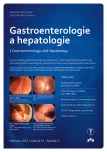Mesalazine in Crohn’s disease: obsolete or neglected treatment?
Authors:
D. Ďuricová
Authors‘ workplace:
Klinické a výzkumné centrum pro střevní záněty, Iscare Lighthouse, Praha
Published in:
Gastroent Hepatol 2013; 67(1): 22-24
Category:
IBD: Review Article
Overview
Aminosalicylates have been used in the treatment of inflammatory bowel disease since the 1940s. These preparations are very effective in treatment of mild to moderate ulcerative colitis. However, their role in the treatment of Crohn’s disease is rather controversial. Several clinical studies and meta-analyses have so far failed to prove their efficacy in Crohn’s disease treatment. Subsequently, national and international guidelines did not recommend using aminosalicylates to treat Crohn’s disease. This article gives an overview of the role of aminosalicylates in Crohn’s disease and provides some evidence supporting the fact that aminosalicylates still have a place in the treatment of a certain group of patients with Crohn’s disease.
Key words:
sulfasalazine – mesalazine – Crohn’s disease – therapy
The author declares she has no potential conflicts of interest concerning drugs, products, or services used in the study.
The Editorial Board declares that the manuscript met the ICMJE „uniform requirements“ for biomedical papers.
Submitted:
4. 2. 2013
Accepted:
7. 2. 2013
Sources
1. Caprilli R, Cesarini M, Angelucci E et al. The long journey of salicylates in ulcerative colitis: The past and the future. J Crohn Colitis 2009; 3(3): 149–156.
2. Desreumaux P, Ghosh S. Review article: mode of action and delivery of 5-aminosalicylic acid – new evidence. Aliment Pharmacol Ther 2006; 24 (Suppl 1): 2–9.
3. Ford AC, Achkar JP, Khan KJ et al. Efficacy of 5-aminosalicylates in ulcerative colitis: systematic review and meta-analysis. Am J Gastroenterol 2011; 106(4): 601–616.
4. Travis SPL, Stange EF, Lemann M et al. European evidence-based Consensus on the management of ulcerative colitis: Current management. J Crohn Colitis 2008; 2(1): 24–62.
5. Akobeng AK, Gardener E. Oral 5-aminosalicylic acid for maintenance of medically-induced remission in Crohn’s Disease. Cochrane Database Syst Rev 2005; CD003715.
6. Ford AC, Kane SV, Khan KJ et al. Efficacy of 5-aminosalicylates in Crohn’s disease: systematic review and meta-analysis. Am J Gastroenterol 2011; 106(4): 617–629.
7. Ford AC, Khan KJ, Talley NJ et al. 5-aminosalicylates prevent relapse of Crohn’s disease after surgically induced remission: systematic review and meta-analysis. Am J Gastroenterol 2011; 106(3): 413–420.
8. Gordon M, Naidoo K, Thomas AG et al. Oral 5-aminosalicylic acid for maintenance of surgically-induced remission in Crohn’s disease. Cochrane Database Syst Rev 2011; CD008414.
9. Lim WC, Hanauer S. Aminosalicylates for induction of remission or response in Crohn’s disease. Cochrane Database Syst Rev 2010; CD008870.
10. Steinhart AH, Forbes A, Mills EC et al. Systematic review: the potential influence of mesalazine formulation on maintenance of remission in Crohn’s disease. Aliment Pharmacol Ther 2007; 25(12): 1389–1399.
11. Dignass A, Van Assche G, Lindsay JO et al. The second European evidence-based consensus on the diagnosis and management of Crohn’s disease: Current management. J Crohn Colitis 2010; 4(1): 28–62.
12. Mowat C, Cole A, Windsor A et al. Guidelines for the management of inflammatory bowel disease in adults. Gut 2011; 60(5): 571–607.
13. Munkholm P, Langholz E, Davidsen M et al. Disease activity courses in a regional cohort of Crohn’s disease patients. Scand J Gastroenterol 1995; 30(7): 699–706.
14. Odes S, Vardi H, Friger M et al. Clinical and economic outcomes in a population-based European cohort of 948 ulcerative colitis and Crohn’s disease patients by Markov analysis. Aliment Pharmacol Ther 2010; 31(7): 735–744.
15. Silverstein MD, Loftus EV, Sandborn WJ et al. Clinical course and costs of care for Crohn’s disease: Markov model analysis of a population-based cohort. Gastroenterology 1999; 117(1): 49–57.
16. Bokemeyer B, Katalinic A, Klugmann T et al. Predictive factors for a mild course of Crohn’s disease. J Crohn Colitis 2009; 3: S82–S83.
17. Duricova D, Pedersen N, Elkjaer M et al. 5-Aminosalicylic acid dependency in Crohn’s disease: A Danish Crohn Colitis Database study. J Crohn Colitis 2010; 4(5): 575–581.
18. Loftus EV Jr., Kane SV, Bjorkman D. Systematic review: short-term adverse effects of 5-aminosalicylic acid agents in the treatment of ulcerative colitis. Aliment Pharmacol Ther 2004; 19(2): 179–189.
19. Gisbert JP, Gonzalez-Lama Y, Mate J. 5-Aminosalicylates and renal function in inflammatory bowel disease: a systematic review. Inflamm Bowel Dis 2007; 13(5): 629–638.
20. Van Staa TP, Travis S, Leufkens HG et al. 5-aminosalicylic acids and the risk of renal disease: a large British epidemiologic study. Gastroenterology 2004; 126(7): 1733–1739.
21. Prokopová L, Ďuricová D, Bortlík M et al. Doporučené postupy pro podávání aminosalicylátů u nemocných s idiopatickými střevními záněty. Gastroent Hepatol 2012; 66(5): 391–400.
Labels
Paediatric gastroenterology Gastroenterology and hepatology SurgeryArticle was published in
Gastroenterology and Hepatology

2013 Issue 1
Most read in this issue
- Segmental portal hypertension
- Current opinion on the therapy of perianal fistulas in patients with Crohn’s disease
- Perforated gangrenous cholecystitis
- Dysfunction of upper gastrointestinal tract in critically ill patients: current view and prospects
